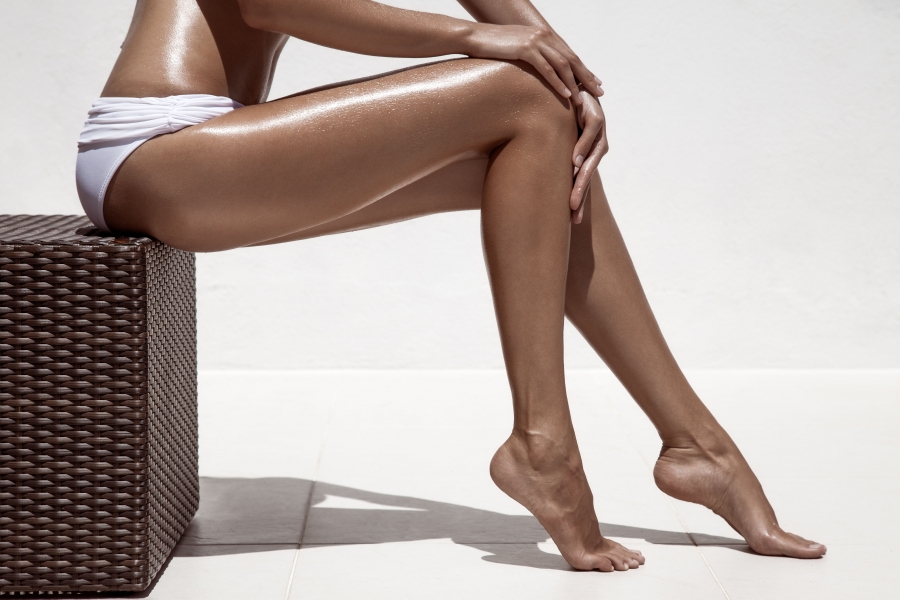Faux Fun in the Sun: Sunless Options for Protection & Prevention
Written by Kylie RumballThere was a time when clients would spend hours in the sun trying to achieve the perfect tan –lathering on lotions and oils aimed at encouraging deep color development with no consideration for long-term skin damage and health risks. While everyone loves the idea of a suntan, skin cancer is not worth the temporary glow. Thankfully, there is growing awareness of the dangers of clients exposing themselves to continuous sun exposure, and they are looking for safe alternatives.
Clients that still want that sun-kissed glowwithout exposure to the sun’s damaging ultraviolet rays now have the choice of FDA-approved, safe high-quality topical applications.Self-tanning products can now be applied topically by hand, sprayed on at home, airbrushed by a practitioner, or sprayed in a tanning booth with misters. Topical self-tanners mainly rely on the active ingredient dihydroxyacetone (DHA) to create a reaction in the skin that makes it appear darker than normal and can last seven to10 days.
DIHYDROXYACETONE
Dihydroxyacetone (DHA)is a three-carbon sugar, also known as glycerone or dihydroxy-2-propanone and is often derived from plant sources. DHA reacts with the amino groups of the proteins in the stratum corneum in a Maillard reaction to produce pigments called melanoidins. These pigments impart the brown color associated with self-tanning products. Results are generally seen within a few hours of application. Ultraviolet light exposure is not needed to initiate this chemical reaction.
DHA is added to lotions, sprays, creams, and foams and are intended to be rubbed or sprayed onto skin, with the result ofskin looking darker than it normally would.
Practitioner-applied spray tanning has gained enormous popularity over the years due to the superior results and advantages, such as fast and even coverage, the ability to customize the DHA strength depending on skin tone and results required, blend uneven skin tone, and the accessibility to hard-to-reach places.
SELF-TANNER SAFTEY
DHA was FDA-approved in the 1970s. The first sunless tanning products were marketed in the late 70s, and spray tans were commercially available in the late 1990s. Self-tanning products have been on the market for nearly 50-years, and these products have been used by possibly millions of Americans over that time. The timeover which these personal products have been in use without significant reports of adverse effects does seem to speak to their general safety.
There is a very small chance that some users will encounter allergic reactions to sunless tanning lotions or sprays, and it is important to take precautions with mucus membranes and areas of thinner skin, as those are the most likely to demonstrate allergies. The FDA has advised clients using automated tanning booths to wear suitable eye protection, nasal plugs, and lip balm. This is to reduce any absorption into the mucous membranes.
SUNSCREEN IS A NECESSITY
While a sunless tan might look like a natural tan, it does not work like one. Sunless tanners do not provide any protection against ultraviolet radiation. It is essential that clients be advised that it is still necessary to wear sun-protective clothing and use a reputable sunscreen with a minimum of SPF 30.
PRODUCT EQUALITY
When considering the best products forclients, it is important to conduct research. Points to consider includeif the item is manufactured by the brand or a third-party, the ability for direct contact for product related education, and if the item had to undergo sea travel, thus exposing its sensitive ingredients to extremes in temperature. Verify and understand the intent of ingredients, expiration dates, and whether to buy from the source or a distributor where the product may have sat for months beforesold. Lastly, understand the DHA strength of the products being recommended and used so that a client’s full expectations are met and that the end result is a flawless-looking natural tan.
